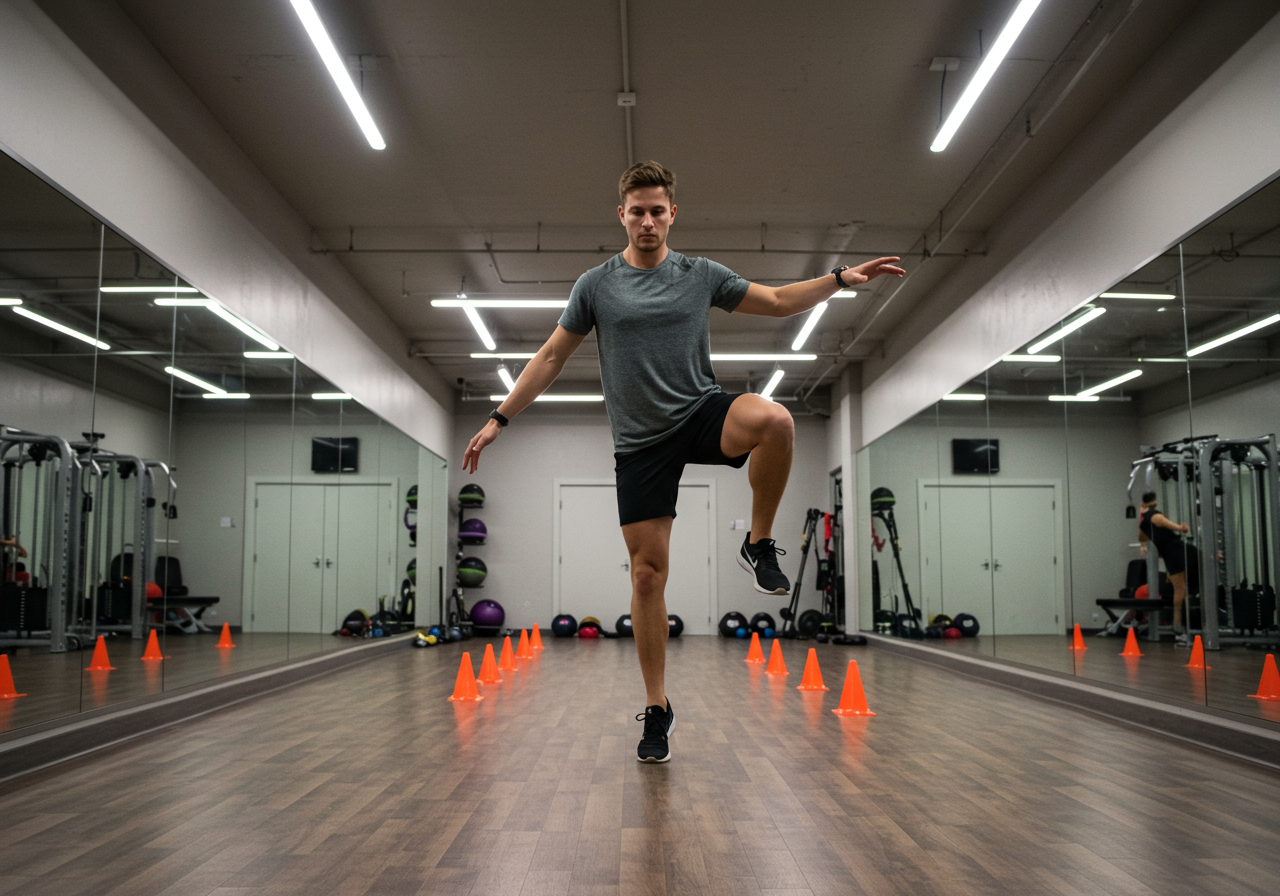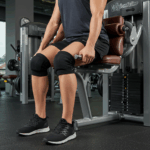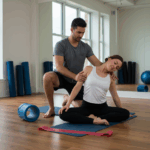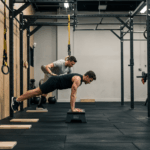Balance is your base: how your body stays upright

Balance connects strength, cardio, and mobility into one system
Balance begins at your feet and your inner ear. Your eyes then refine the picture. Your brain coordinates all three systems.
Good balance lowers injury risk and improves lifting efficiency. It also improves running economy and walking confidence.
I coach balance first during warm-ups. I then reinforce it within strength and cardio sessions.
- Single-Leg Stand, eyes open: stand on one leg. Aim for 20–30 seconds.
- Heel-to-Toe Walk: ten steps forward on a straight line. Count wobbles.
- Sit-to-Stand Test: as many controlled stands in 30 seconds as possible.
- Head-Turn Gaze: stand tall, fix gaze on a letter. Rotate head left-right gently for 20 seconds.
Record times and wobbles to track progress.
| Test | Baseline | Week 4 | Week 8 |
|---|---|---|---|
| Single-Leg Stand (sec) | |||
| Heel-to-Toe Wobbles (count) | |||
| Sit-to-Stand 30s (reps) | |||
| Head-Turn Gaze Sway (low/med/high) |
I start beginners with eyes-open drills and wide stances. I then reduce support gradually.
Your daily balance routine: simple, focused, effective

Short daily sessions build balance faster than occasional long workouts
This routine fits inside warm-ups or walks. You need five to fifteen minutes.
Start with foot activation. Then challenge posture, eyes, and head position safely.
- Foot Tripod Setup, 1 minute per side. Press big toe, little toe, heel.
- Ankle Rocks, 2 sets of 10. Keep knees soft.
- Tandem Stand, 3 x 20–30 seconds per side. Hold a counter if needed.
- Head-Turn Gaze, 3 x 20 seconds. Keep breath calm.
- Supported Single-Leg Hinge, 2 x 8 per side. Light touch on wall.
- Carry Finisher, 2 x 30 meters farmer carry. Walk slow and tall.
| Day | Focus | Key Drill | Notes |
|---|---|---|---|
| Mon | Stable base | Tandem stand | Eyes forward, slow breath |
| Tue | Dynamic | Single-leg hinge | Light wall support |
| Wed | Head/eyes | Head-turn gaze | Limit motion if dizzy |
| Thu | Reactive | Partner taps | Soft knees |
| Fri | Loaded | Farmer carry | Walk slow, tall posture |
| Sat | Vision | Near-far focus | Switch focus every 2 seconds |
| Sun | Recovery | Walk + mobility | Zone 1–2 only |
I pair this with light cardio. I use slow nasal breathing during drills.
Progressions: beginner to advanced, then integrate with strength and cardio

Start stable, add movement, then add load and reactivity
You progress by narrowing support, moving hips, and adding load. You also add head motion.
Use clear milestones to move levels. Do not skip steps.
| Level | Drills | Sets x Reps/Time | Rest | Advance when |
|---|---|---|---|---|
| Beginner | Tandem stand, supported hinges, heel-to-toe walk | 3 x 20–30s holds; 2 x 8 reps | 45–60s | Hold 30s with minimal sway |
| Intermediate | Single-leg stands, step-downs, head-turn gaze | 3 x 20–40s; 3 x 6–8 reps | 60–75s | Control head turns without dizziness |
| Advanced | Single-leg RDL, lateral hops, loaded carries, perturbations | 3–4 x 5–6 reps; 2–3 x 30–40m | 75–90s | Land soft with full control |
I integrate this with strength training. I use split squats between upper body sets.
I integrate this with cardio. I add 20-second balance holds every five minutes during a Zone 2 walk.
My typical session lasts 45–60 minutes. Average heart rate sits in Zone 2.
- Warm-up: Foot tripod, ankle rocks, 6 minutes total.
- Strength A: Goblet squat 3 x 8. Superset with single-leg stand 3 x 30s.
- Strength B: Dumbbell row 3 x 10. Superset with step-downs 3 x 6/side.
- Carry Finisher: Suitcase carry 3 x 30m each side.
- Cardio: 20 minutes Zone 2. Insert two balance intervals.
Make it stick: schedule, tracking, nutrition, and troubleshooting

Simple scheduling and recovery keep your progress consistent
I program three balance-focused micro-sessions weekly. I also attach short drills to every workout warm-up.
Here is a four-week rollout that I use with beginners.
- Week 1: 5–8 minutes per day. Focus on tandem stance and supported hinges.
- Week 2: 8–10 minutes per day. Add head-turn gaze and step-downs.
- Week 3: 10–12 minutes per day. Add loaded carries and single-leg stands.
- Week 4: 12–15 minutes per day. Add perturbations and lateral hops if ready.
I track heart rate using Garmin. I keep walks mostly in Zone 2.
My Monday session last week was 52 minutes. Average heart rate was 132 bpm.
I used two 14 kg kettlebells for carries. I progressed one kilogram from the prior week.
| Metric | Mon | Wed | Fri |
|---|---|---|---|
| Single-Leg Stand Best (sec) | 34 | 36 | 38 |
| Carry Load per Hand | 14 kg | Rest | 14 kg |
| Avg HR (bpm) | 132 | Rest | 129 |
My calories range from 2,300 to 2,500 daily. I increase by 200 kcal on heavy carry days.
I sleep 7.5–8.5 hours nightly. I nap 20 minutes on busy weeks.
I use creatine monohydrate 3–5 g daily. I use magnesium glycinate 200–400 mg at night.
Use these fixes for common problems. If your ankle wobbles, shorten stance and add foot tripod practice.
If your knee caves, slow down and keep knee over middle toes. Reduce load until control returns.
If motivation dips, log wins daily and schedule five-minute micro-sessions. Small reps beat missed workouts.
If progress stalls, change the sensory demand. Add head-turns or switch surfaces, not both at once.
I track with Garmin for heart rate and steps: garmin.com
I log food with MyFitnessPal to hold macros steady: myfitnesspal.com
Proof that it works: data from my training and clients

Measured outcomes and long-term result interpretation
Real numbers matter. I track balance, strength, and endurance changes over eight weeks.
| Outcome | Week 0 | Week 8 | Change |
|---|---|---|---|
| Single-Leg Stand Right | 22 sec | 44 sec | +100% |
| Single-Leg Stand Left | 18 sec | 40 sec | +122% |
| Y-Balance Composite | 86% | 93% | +7 pts |
| Zone 2 VO2 proxy | 11:30 min/mi @ 135 bpm | 10:30 min/mi @ 135 bpm | ~8% improvement |
| 5RM Goblet Squat | 36 kg | 44 kg | +22% |
Client Sara, 42, said, “Stairs feel safer. I stopped grabbing the rail.”
Client Marco, 58, said, “My ankle finally feels stable during hikes.”
My reflection is honest. HIIT cut fat faster for me. However, Zone 2 plus balance practice improved endurance and posture more.
Wobble boards raised awareness for beginners. Yet ground-based carries and hinges improved real-life control much better.
I made mistakes. I once skipped warm-up and strained my calf during hops. I now always prime ankles first.
I verify changes with my Garmin data and test logs. Consistent practice beats fancy tools.






